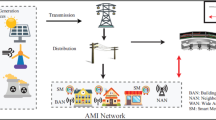Abstract
Modern middle class Indian homes are equipped with multiple appliances such as refrigerator, tube lights, television, fans, washing machine and electric water heater with different ratings. At the end of each month, electricity distribution agency provides monthly bill to its customers. On this bill, the total consumption of electricity for the home is shown. However, this bill does not inform equipment wise power consumption, or its contribution in the total bill. In short, user does not know which equipments is mostly responsible for the total bill of the month. This information may be critical to take energy saving steps to reduce monthly consumption to lowest possible level. To satisfy this objective, it is necessary to have a system which will record power consumption of every device at home. In this paper, related literature is synthesized to design a proposed method of measurement and conceptual system architecture.



Similar content being viewed by others
References
Shahi, R. V. Energy markets and technologies in India. http://www.powermin.nic.in/whats_new/pdf/energy%20markets%20&%20technologies-REVISED1.pdf. Downloaded on 29 Jan 2013.
Cho, H. S., Chang, H. S., & Baek, S. H. Wide range electric power consumption monitoring system with dynamic resistance control system.
Murata, H., et al. (2001). Applying kernel based subspace classification to a non-intrusive monitoring system for household electric appliances. ICANN2000 692498.
Onoda, T., et al. (2000). Applying support vector machines and boosting to a non-intrusive monitoring system for household electric appliances with inverters. NC’2000.
Murata, H., & Onoda, T. Estimation of power consumption for household electric appliances. ICONIP’ 2002 (Vol. 5, pp. 2299–2303).
Yongpan, C. Development of monitoring system of building energy consumption (Vol. 2, pp. 363–366). Harbin, China: School of Municipal & Environ. Engineering, Harbin Institute of Technology.
Heo, J., Kang, S. B., Jeon, S. S., JoonHeo, et al. (2008). Design and implementation of control mechanism for standby power reduction. IEEE Transactions on Consumer Electronics, 54.
Serra, H., et al. (2005). Domestic power consumption measurement and automatic home appliance detection. Faro, Portugal.
Ito. M., et al. A method of appliance detection based on features of power waveform. In Proceedings of the international symposium on applications and the internet in 2004.
Lien, C.-H., et al. (2007). Remotely controllable outlet system for home power management. IEEE Transactions on Consumer Electronics, 53(4).
Lien, C.-H., Bai, Y.-W., & Li, M.-B. (2006). Remote-controlled power outlet system for home power management. IEEE. 1-4244-0216-6/06/\({\$}\)20.00.
Ray, S., Starobinski, D. & Trachtenberg, A. (2004). Robust location detection with sensor networks. IEEE Journal on Selected Areas in Communications, 22(6).
Valtchev, D., & Frankov, I. (2002). Service gateway architecture for a smart home. IEEE Communications Magazine.
Cho, H. S., et al. Simple and robust method for detecting the electrical appliances using markers and programmable logic devices. The IEEE international symposium on consumer electronics (ISCE2009).
Shibata, T. et al. (2005). The new architecture that realizes seamless connectivity and cooperative control for home network systems. Consumer Electronics, Digest of Technical Papers. doi:10.1109/ICCE.2005.1429761.
Bae, C., Yoo, J., Kang, K., Choe, Y., & Lee, J. (2005). Home server for home digital service environments. IEEE Transactions on Consumer electronics, 49(4).
Murata, H., & Onoda, T. (2002). Estimation of power consumption for household electric appliances. Neural information processing, ICONIP ’02 (vol. 5). doi:10.1109/ICONIP.2002.1201903.
http://www.dailymail.co.uk/indiahome/indianews/article-2327182/The-myth-great-Indian-Middle-class-Roughly-30-Indias-population-lives-poverty-line.html. Accessed 10 Jan 2014.
Author information
Authors and Affiliations
Corresponding author
Rights and permissions
About this article
Cite this article
Shinde, S.V., Bhardwaj, S. Power Consumption Monitoring System for Indian Homes. Wireless Pers Commun 76, 409–418 (2014). https://doi.org/10.1007/s11277-014-1714-2
Published:
Issue Date:
DOI: https://doi.org/10.1007/s11277-014-1714-2




